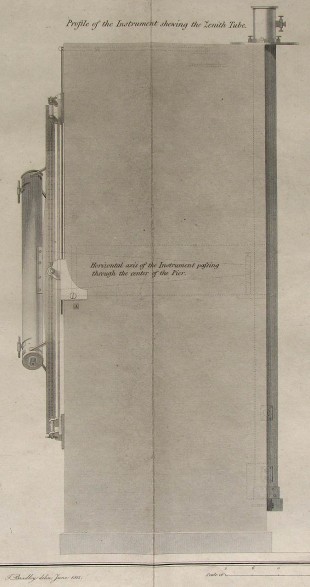The Royal Observatory Greenwich
…where east meets west
- Home
- Brief History
- The Greenwich Meridian
- Greenwich
(1675–1958) - Herstmonceux
(1948–1990) - Cambridge
(1990–1998) - Outstations (1822–1971)…
- – Chingford (1822–1924)
- – Deal
(1864–1927) - – Abinger
(1923–1957) - – Bristol & Bradford on Avon
(1939–1948) - – Bath
(1939–1949) - – Hartland
(1955–1967) - – Cape of Good Hope
(1959–1971)
- Administration…
- – Funding
- – Governance
- – Inventories
- – Pay
- – Regulations
- – Royal Warrants
- Contemporary Accounts
- People
- Publications
- Science
- Technology
- Telescopes
- Chronometers
- Clocks & Time
- Board of Longitude
- Libraries & Archives
- Visit
- Search
Telescope: Pond’s 9½-foot Zenith Tube (1812)
This page is currently under construction
The instrument currently forms part of the collection of the National Maritime Museum. Object ID: AST0994. John Belville records in his journal that the instrument was erected at Greenwich on 12 Jan 1813 (RGO6/1/53)
Description from volume 2 of Pearson’s An introduction to practical astronomy
The tube is ten feet in length, and five inches in diameter; and is a reflecting telescope of the Newtonian kind: it has, from end to end, half its diameter let into the wall, as shown in the figure. The tube of the telescope itself forms the vertical axis, on which the reversion is made, for measuring zenith distances with the micrometer, both to the east and west: at the lower end it turns on a hollow pivot, which works in a socket fastened to the wall; at the upper end, the tube is embraced by a collar, worked circular with the greatest care; which collar bears against an angle made in a strong plate, connected with the wall, and is pressed by two springs, into close contact with the angle. There are three spring rollers affixed to the tube, which roll on a. horizontal circular plate at the top; these relieve the pivot below from a great part of the weight, and assure an easy and steady motion. The large speculum at the lower end is fixed in the tube so as to form a small angle with the axis, in the manner that Sir W. Herschel constructed his larger telescopes: this mode was adopted in order to place the small mirror about half way between the axis of the tube and the wires of the micrometer; the plumb-line occupies the axis of the tube, and when every thing is adjusted, the instrument may be reversed, or turned half round, without giving sensible motion to the plumb-line; which expedient prevents the loss of time that an excentric plumb-line requires in coming to rest. The large mirror is perforated through its centre, for the plumb-line to pass through; for the plummet and water-pot have their station much below. The lower end of the plumb-line is viewed as bisecting the luminous discs of two microscopes, placed at right angles to each other; at the upper end it is suspended by an apparatus, in which there are adjustments for making it central, and which do not intercept many of the incident rays. The parallel rays from a star, falling upon the large mirror, are returned in a converging state upon the small one, by which they are turned into a horizontal direction, and come to a focus in the field of view of a parallel line micrometer, where the image is seen by an eye-glass magnifying about 100 times. It is evident that the range of observation in this instrument is confined within the field of view, which is not more than 15’ on each side of the zenith; yet this is amply sufficient for the purpose it was intended for.© 2014 – 2025 Graham Dolan
Except where indicated, all text and images are the copyright of Graham Dolan
